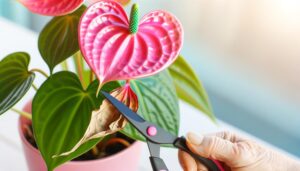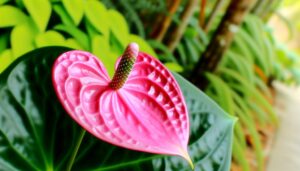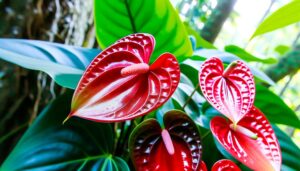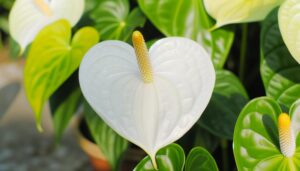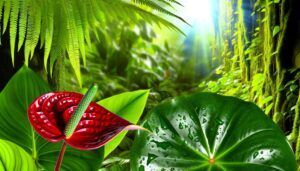Why Is the Anthurium Red Giant Unique?
The Anthurium Red Giant is distinguished by its striking red spathes, attributed to anthocyanin compounds, and its glossy, lustrous foliage due to a waxy cuticle layer. This species exhibits rapid vertical growth with significant leaf size variation, adapted to neotropical ecozones.
Its specific care requirements include indirect bright light, high humidity, and well-draining soil. Additionally, its epiphytic nature and hygroscopic roots optimize water management in high humidity environments.
This plant's vibrant appearance and robust growth habit have garnered popularity among botanical collectors. For an in-depth understanding, one could explore its unique adaptations and horticultural care.
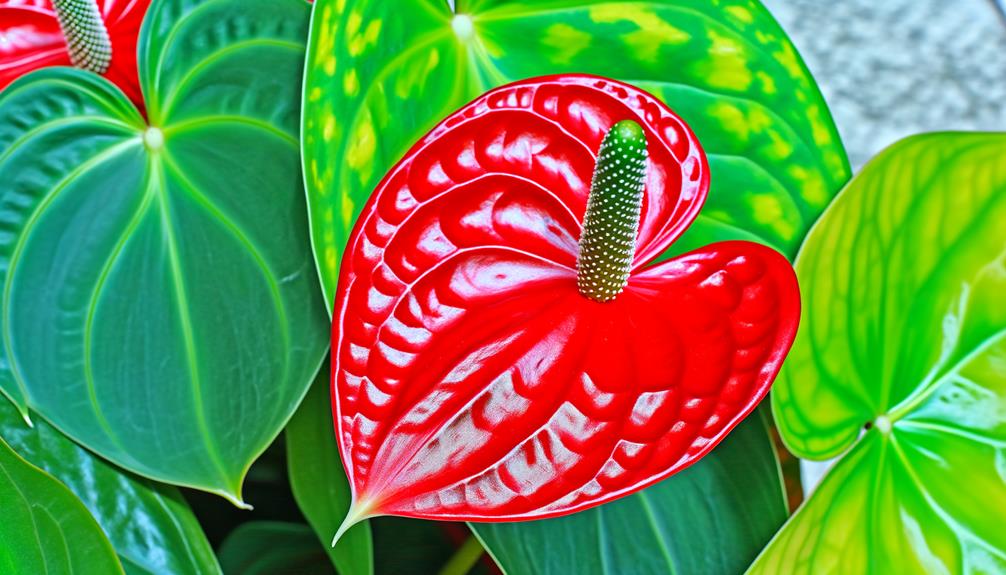
Key Takeaways
- Anthurium Red Giant features striking red spathes that encase the spadix, enhancing its ornamental appeal.
- Its glossy, waxy foliage and significant leaf size variation optimize photosynthetic efficiency.
- The plant exhibits rapid vertical expansion and accelerated growth driven by robust apical meristem activity.
- Distinctive anthocyanin compounds in the bracts give them a vivid red color, attracting pollinators.
- Limited availability and resilient nature make it a prized possession among plant collectors.
Striking Red Spathes
The Anthurium Red Giant is distinguished by its striking red bracts, which are modified leaves that encase the plant's spadix and serve as a key feature in its reproductive anatomy. These vibrant bracts are not only visually captivating but also play an essential role in attracting pollinators.
The spadix, a cylindrical structure, houses numerous tiny flowers that rely on the bracts for successful pollination. The vivid red pigmentation is attributed to anthocyanin compounds, which are necessary for deterring herbivores and attracting specific pollinators.
Additionally, the bracts' sturdy texture provides protection to the reproductive organs, ensuring the longevity of the plant's reproductive cycle. This unique feature underscores the evolutionary adaptability and ecological significance of the Anthurium Red Giant.
Glossy Foliage
Boasting a lustrous finish, the Anthurium Red Giant's foliage displays a glossy sheen that enhances its visual charm and assists in optimizing light absorption. This attribute is due to the waxy cuticle layer on the leaf surface, which not only gives a stunning sheen but also plays a practical role in reducing water loss through transpiration.
Moreover, the high gloss of the leaves helps in reflecting excess light, thus preventing photoinhibition. The sturdy leaf structure is supported by a well-developed vascular system, aiding in efficient nutrient and water transportation.
This intricate interplay of anatomical features makes the foliage of Anthurium Red Giant not just visually appealing but also highly functional, highlighting its unique adaptability in various environmental conditions.
Growth Patterns
Anthurium Red Giant exhibits a distinct growth pattern characterized by rapid vertical expansion, resulting in a prominent stature within a relatively short period.
The species also demonstrates significant leaf size variation, with mature leaves often reaching substantial dimensions, contributing to its unique aesthetic.
Additionally, its root development is notable for robust and extensive root systems that support its vigorous growth and nutrient uptake.
Rapid Vertical Expansion
Rapid vertical expansion in Anthurium Red Giant is characterized by accelerated apical meristem activity, resulting in elongated internodes and substantial stem elongation. This phenomenon is primarily driven by enhanced cell division and differentiation at the shoot apex, facilitated by elevated auxin concentrations.
The pronounced elongation of internodal regions allows the Anthurium Red Giant to optimize light capture and spatial dominance in its native understory habitat. Moreover, the robust elongation is complemented by lignification processes that confer structural integrity to the markedly extended stems.
This rapid vertical growth not only affords the plant a competitive advantage in densely vegetated environments but also enhances its ornamental value, making it a sought-after species for both indoor and outdoor horticultural applications.
Leaf Size Variation
In tandem with its pronounced vertical expansion, the Anthurium Red Giant exhibits significant leaf size variation characterized by distinct heteroblasty and allometric growth patterns, which play a pivotal role in optimizing photosynthetic efficiency and adaptive responses to fluctuating light conditions within its native understory habitat.
This variation is evident in several critical aspects:
- Juvenile leaves: Smaller, more lobed, and often softer in texture compared to mature foliage.
- Mature leaves: Substantially larger, more rigid, and capable of greater light interception.
- Allometric scaling: Leaf area increases disproportionately with plant height, enhancing overall light capture.
- Morphological plasticity: Adaptability in leaf morphology allows dynamic responses to environmental changes, particularly light gradients.
These features underscore the Anthurium Red Giant's evolutionary adaptations, ensuring its ecological success.
Root Development Characteristics
Root development in the Anthurium Red Giant showcases an intricate structure marked by both strong primary roots and a network of delicate, side roots that facilitate efficient nutrient uptake and anchorage.
The primary roots, often thick and lignified, provide structural stability, penetrating deeply into the substrate to access water reservoirs.
In contrast, the side roots extend horizontally, forming a dense mat that maximizes soil contact and enhances nutrient absorption. Root hairs proliferate on these lateral extensions, increasing the root surface area and optimizing nutrient exchange.
Additionally, the presence of mycorrhizal associations further enhances nutrient acquisition, particularly phosphorus.
This dual root system architecture, combining vertical and horizontal growth patterns, guarantees the Anthurium Red Giant's resilience and adaptability in diverse soil conditions.
Care Requirements
Ensuring best care for Anthurium Red Giant involves maintaining precise environmental conditions, including specific light, humidity, and soil requirements. Optimal growth is achieved by adhering to the following parameters:
- Light: Indirect, bright illumination resembles the dappled sunlight of its native habitat, preventing photoinhibition and leaf scorch.
- Humidity: A relative moisture level of 70-80% is essential, as xeric conditions can lead to desiccation and impaired physiological functions.
- Soil: A well-draining, organic-rich substrate is essential, incorporating components such as orchid bark and perlite to emulate its epiphytic nature.
- Watering: Consistent moisture is vital, but waterlogging must be avoided to prevent rhizome rot and ensure aeration of the root zone.
These parameters are fundamental for the Anthurium Red Giant's vigorous growth and health.
Tropical Origins
The Anthurium Red Giant Unique thrives in its native tropical habitat, specifically within the neotropical ecozones of Central and South America.
This species exhibits remarkable adaptations to high humidity and consistent temperatures, which are characteristic of its natural environment.
Understanding these climate adaptation strategies is essential for replicating best growth conditions in non-native settings.
Native Habitat Details
Commonly found in the humid understories of Central and South American rainforests, Anthurium Red Giant thrives in the rich, well-draining soils of these tropical ecosystems. This species is adept at exploiting the microclimatic conditions provided by its native habitat, favoring areas with high humidity and consistent moisture levels. The intricate interplay of biotic and abiotic factors in these regions supports the plant's growth and reproduction cycles.
Humidity: Constant high humidity levels aid in maintaining turgidity and physiological processes.
Shade: Partial to full shade from the rainforest canopy prevents leaf scorch and optimizes photosynthesis.
Soil Composition: Nutrient-rich, well-draining soils provide essential minerals and prevent root rot.
Temperature: Stable, warm temperatures foster metabolic activities and growth.
These factors collectively contribute to the unique ecological niche of the Anthurium Red Giant.
Climate Adaptation Strategies
Given the Anthurium Red Giant's reliance on the stable, humid microclimate of its native rainforest habitat, its climate adjustment strategies are finely tuned to optimize physiological functions and survival in tropical conditions. Key adjustments include hygroscopic roots, which enhance moisture absorption, and a waxy cuticle that minimizes transpiration. These features facilitate best water management, essential for maintaining turgor and cellular function in high humidity environments.
| Adjustment | Function |
|---|---|
| Hygroscopic roots | Improved moisture absorption |
| Waxy cuticle | Reduced transpiration |
| Epiphytic growth | Access to light and air |
Additionally, its epiphytic growth habit allows the Anthurium Red Giant to access light and air circulation, reducing competition and fostering ideal photosynthetic conditions. These adjustments collectively underscore the species' evolutionary success in tropical ecosystems.
Popularity Among Collectors
Why does the Anthurium Red Giant garner such immense popularity among dedicated collectors and botanical enthusiasts?
The Anthurium Red Giant's allure lies in its distinctive attributes that set it apart in botanical circles. Its unique combination of striking physical characteristics and resilient nature makes it a coveted specimen.
- Vibrant Spathes: The Anthurium Red Giant boasts large, vividly colored spathes that captivate onlookers with their intense red hue.
- Foliage Dynamics: Its broad, glossy foliage enhances its visual appeal, providing a lush, tropical aesthetic.
- Growth Habit: This species exhibits a robust growth habit, making it an impressive centerpiece in any collection.
- Rare Availability: Its limited availability in the market increases its desirability, making it a prized possession among collectors.
These qualities underscore its revered status in botanical collections.
Conclusion
The Anthurium Red Giant, with its striking red spathes, glossy foliage, and unique growth patterns, epitomizes botanical magnificence.
Its tropical origins and intricate care requirements make it a coveted specimen among collectors.
This plant, perhaps more demanding than a university thesis, draws enthusiasts into a world where horticultural prowess is both a challenge and a reward.
Only those with a penchant for meticulous care dare to embrace its grandeur, underscoring its elite status in plant collections.

